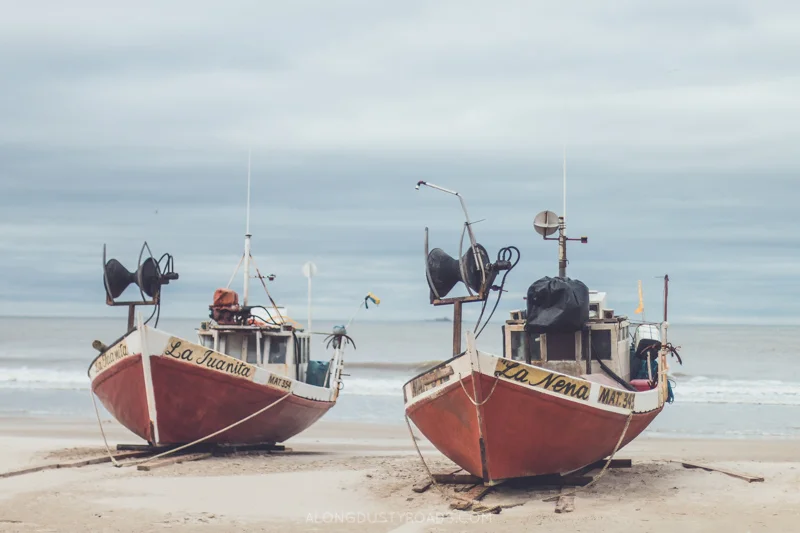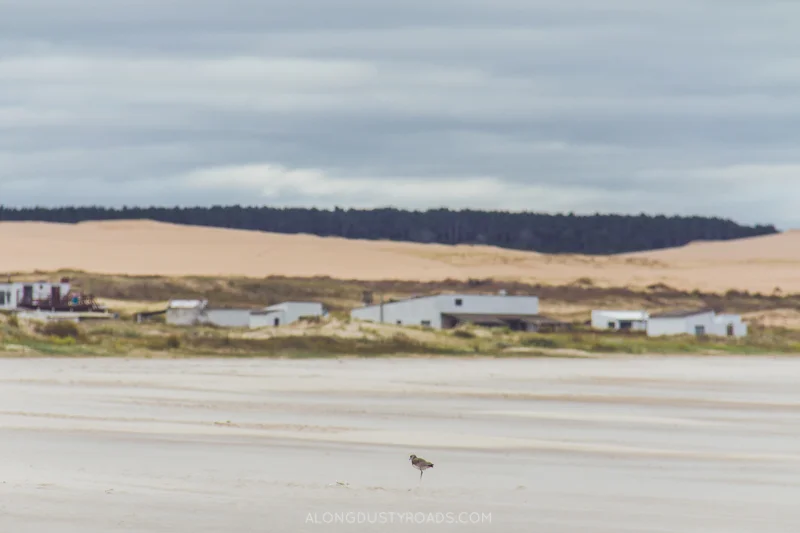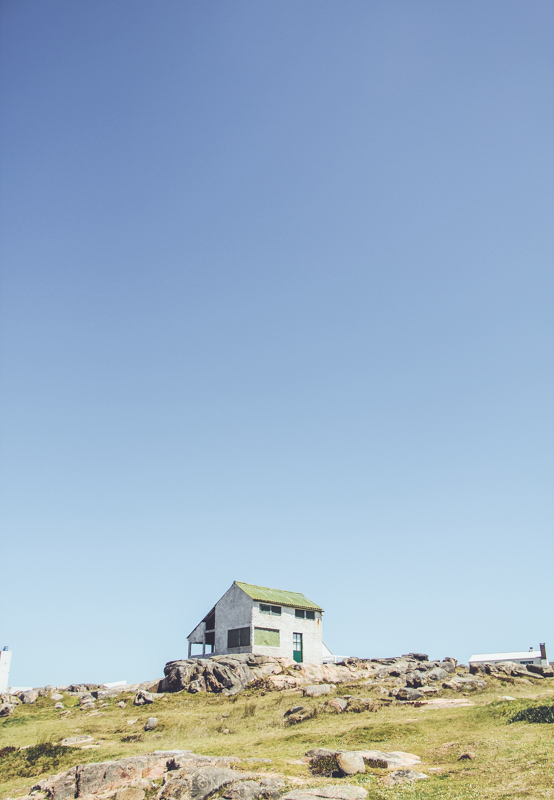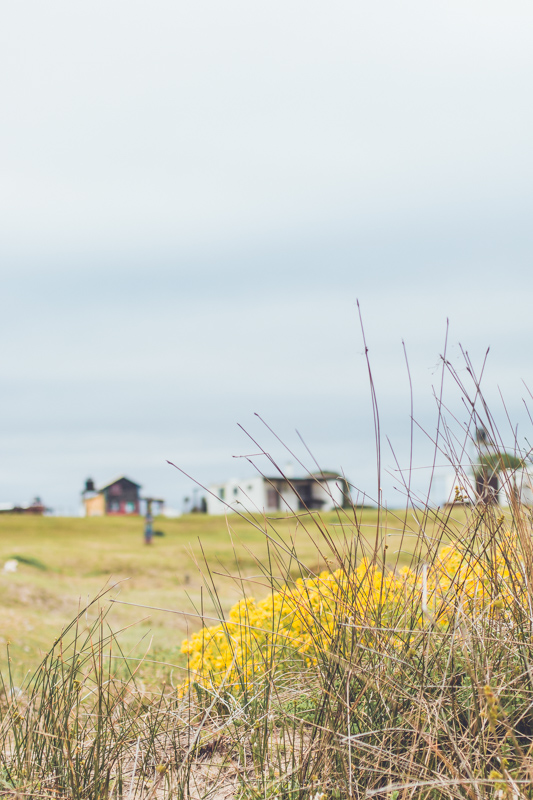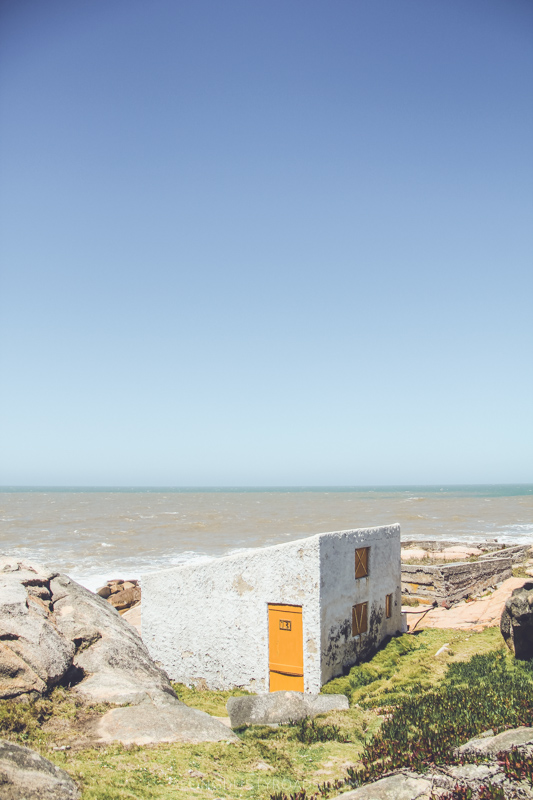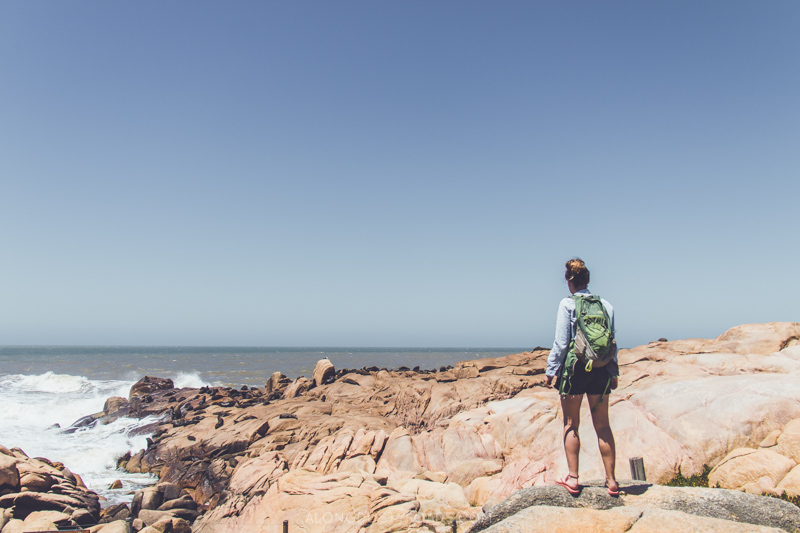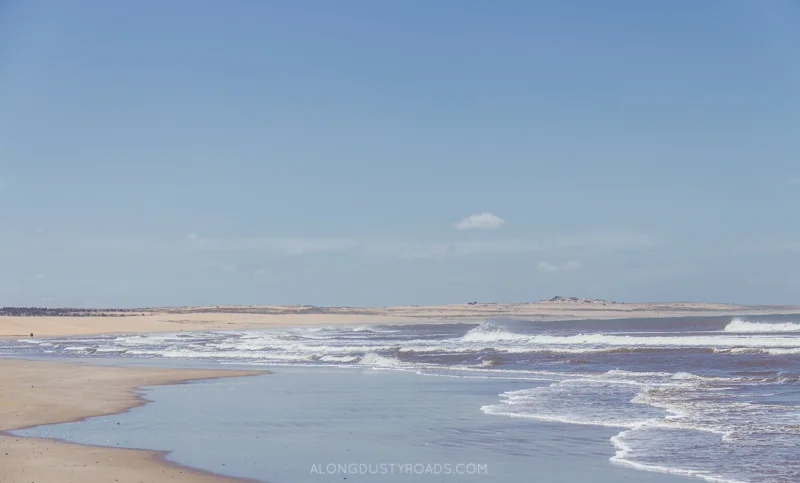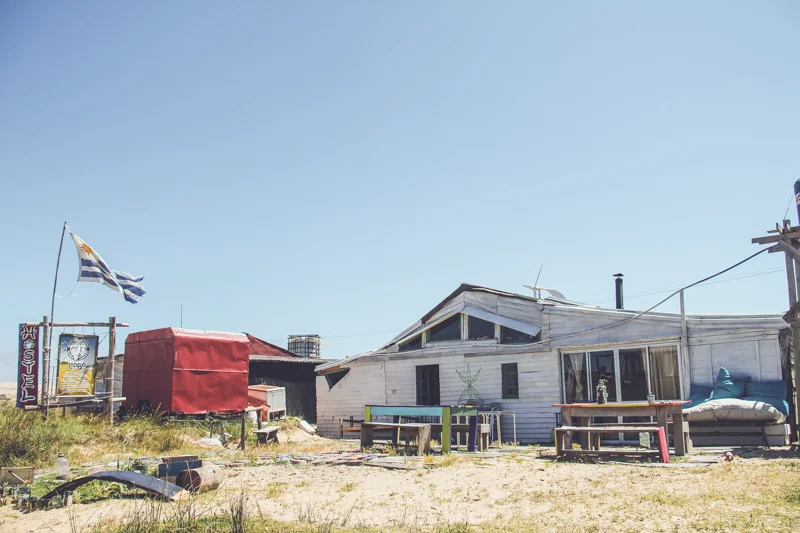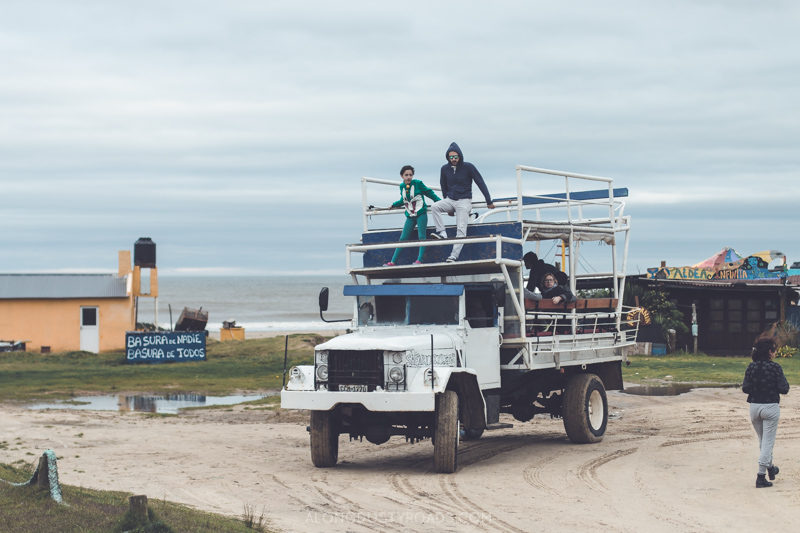A strange place: in parts magical, in parts confounding.
That's how we would sum up Cabo Polonio. We've certainly not visited anywhere else quite like it in South America.
There is no running water, there is no electricity, there is only one shop (which shuts most afternoons) and, wait for it, wi-fi is something consigned to only a handful of places with a generator and willingness to hand out the password. And, most surprisingly, this state of affairs is something the locals not only want but fight to maintain.
We spoke to one business owner, an outsider trying to establish himself, who set up a flood light to attract customers to his restaurant in the evening. "The first night I switched it on, somebody smashed it. When I fixed it, it got smashed again. I stopped trying after that."
Washing with water from wells or collected rainwater, depending on a few renewable energy sources, cooking by candlelight or finding your way along unlit dirt roads by memory or torch is the only way of being here. For some, it's the main reason they come back every year, for others, it would be reason enough to never arrive.
This is, let's remember, Uruguay. Although there are still pockets of poverty, it is one of the most economically prosperous countries in the continent. Things in Cabo could be developed if there was the appetite for it. Around four hours away by bus, you will find Punta del Este, a beach resort for the rich and famous who flock in their thousands from Brazil and Argentina every summer. Try asking anyone there to cook by headlamp.
Cabo Polonio, is also not actually some hidden away off-the-beaten track destination, although it may be promoted as such. Ownership of the land is split between the government, which designated it a protected national park in 2009, and private citizens. Many a Montevidean has a rustic holiday home here, it's one of the most popular spots for young barefooted boho locals to come for fun by the beach and, steadily, it is becoming recognised as a big backpacker draw.
Our journey to this curious anomaly started with a ride in a truck. From a relatively new visitor centre/bus terminal/car park, dozens of people awaited the next open-air double-decker to take them through forest and over dunes. Unless you're a resident with a special vehicle permit (which limits the number of journeys you can make each week), then you have no alternative unless you fancy walking 7 kms.
The first thing we questioned as we approached the village was the ridiculousness of the official population figures we had read elsewhere, ranging between 70-90. Although that may be true in terms of permanent year-round residency, a rough count resulted in more than a house for each resident. As with the rest of the Uruguayan coast, official numbers neglect to cater for the hundreds and thousands who flock to seaside resorts such as Cabo for the brief, but intense, summer season.
The landscapes, however, were breathtaking. Wilderness like this was not something we had imagined would be found on the South American coast in summer but, with storm clouds casting a dark, ominous shadow over everything, and a gale blowing hard, Cabo Polonio looked like a place you'd expect to find on the Scottish Hebrides in winter. Bleak and isolated, yet beautiful.
Small, rustic and sometimes colourful shacks were dotted around the grey-green grassy knolls, some extolling previous Presidents, others a more Caribbean vibe. Decaying red and white fishing vessels and all the accompanying equipment - blue ropes, green nets and the odd discarded catch - banked themselves on the lonely beach. Only us and a few other souls could be seen braving the elements.
That night, a storm came in full force. Playing cards under the harsh light of our headlamps, it felt more like being on the open seas, than between four landed walls. The rain lashed and the wind battered our rustic accommodation - held together by nails, cheap wood and hope rather than anything more solid - but with our little fire and cups of cheap Uruguayan wine, it felt like an adventure.
The next day, we saw a a village transformed. Bathed in bright sunlight, we understood what all the fuss was about.
Criss-crossing the whole area doesn't take much time; on foot, a few hours will allow you to see pretty much everything. There are a few little shack restaurants, run by stoic women, offering cheap and delicious fish or chicken milaneses, where you can enjoy lunch and a beer in the sun. A few stalls sell jewellery and crafts.
Behind the iconic lighthouse - the only artificial light source you may see after dark - is the second-largest sea-lion colony in Uruguay where we spent hours watching them play and spar.
The beaches on either side of the peninsula, Playa Sur and Playa Norte, are naturally gorgeous and, although the ever-present wind might affect your sunbathing experience, they rank as some of the prettiest we saw in the country.
An unforgettable experience from your time here is likely to be watching the sunset - beer, legal joint or mate in hand - from the little wooden shelters on Playa Sur.
However, it is at night that you truly experience the 'buena onda' of Cabo Polonio. What our hostel lacked in locks and electricity, it made up for in creating a special atmosphere once the sun went down.
Bars and clubs aren't really the scene here. Instead, it's sitting around smoky, crackling bonfires with new friends, sharing 1.5 litres bottle of wine, communicating in a mix of Spanish and English and gazing at the thousands of stars punctuating the night sky.
Perhaps smashing the lights of newcomers makes a little more sense once you see this for yourself. Although it might feel a little cliché at times, especially when someone with an out of tune guitar or set of drums joins you, it's impossible not to feel that it is moments like these that you travel for and Cabo Polonio gives you moments like that every single day.
things to know before you visit cabo polonio
Our views on Cabo Polonio were mixed: some parts you'll tolerate, some parts you'll love. The lack of electricity and home comforts is a nice novelty for a few days but, naturally, you start to notice its absence and yearn for some of the convenience it brings. Cooking under a head-torch is neither ideal or that fun, but we managed it each evening and cooked a couple of decent meals.
Here's some useful things to know to cope with the quirks which accompany Cabo's rugged, isolated beauty:
#1 Accommodation across the village is some of the most basic we've seen in South America, although the prices charged throughout the year don't really reflect this with a dorm bed in off-season costing between $400-800 (all prices listed in this article are in Uruguayan peso). If you haven't booked a hostel in advance of arrival, there will usually be people waiting at the truck drop-off point offering rooms or you can easily walk around the village with your backpack and see what's on offer in around 30 minutes.
#2 There are a few businesses which offer facilities to charge your devices for a small cost. However, be aware that these may not always be available and your devices etc may be pretty much redundant for the duration of your stay.
#3 The local shop is quite well stocked and actually very affordable given it's the only option in the village. There's fresh fruit and veg, snacks and a good selection of alcohol. However, its opening hours are limited (we recall it closes for a few hours in the afternoon, before finally shutting its doors at 8 p.m.). If you plan on cooking, it wouldn't be a bad idea to bring some supplies along with you.
#4 A head-light or torch is essential. Whether it's navigating your way back to the hostel after dark, trying to cook a meal or trying to find your pyjamas in a private room, you're going to need it.
#5 There is no ATM, so bring enough cash for the duration of your stay.
#6 The high season from mid-December to mid-January will see thousands flock to Cabo Polonio for a beach holiday. Accommodation prices increase dramatically, as much as triple, in town and demand outstrips supply (one local told us that people pay extraordinary prices pay to sleep on tables and benches). If you're planning on visiting at this time, reservations would be necessary and you'd need to be aware that the atmosphere of the town might change quite a bit.
Check out our post on the five things to know before you travel in Uruguay.
where we stayed
There is a limited amount of accommodation in Cabo Polonio, and it is guaranteed to be of much lower quality than elsewhere in Uruguay. We split our time between a small private room and the 8-person dorm in Lobo Hostel Bar. It's well-located, only a minute from the bus stop and shop, and a short walk to the gorgeous Playa Sur. The owners - a young Argentinian (Nana) and Uruguayan (Gaston) - are extremely welcoming, helpful and friendly and, as we said above, create a lovely atmosphere amongst guests in the evenings.
There was still renovation work going on during our stay, and hopefully this will improve some of the rougher edges we experienced. Some of these are cosmetic but other were more pressing, such as no locks on private room doors and no lockers available (we have said to the owners that such improvements are essential). A small kitchen is available for guest use and wi-fi will be switched on for a brief window each evening (not all hostels do this). It's also one the cheaper hostels you can book on-line - don't believe us? Check out their prices here.
how to get to cabo polonio
Cabo Polonio junction is a well-known drop-off point for buses travelling along Ruta 10. From La Rocha ($159, 90 minutes) or La Paloma ($119, 60 minutes - updated February 2018) take a Rutas del Sol bus to the junction. At the visitor centre/terminal, you are only able to buy a return ticket ($230 - updated February 2018) so remember to keep this safe as you'll need it for leaving Cabo. You may have to wait around a half-hour or so for the next truck to depart and take you the bumpy 7 km, 20 minute ride into Cabo.
From the visitor centre, you will find bus connections eastwards to Punta del Diablo ($100, 60-90 minutes), from where you can travel further into Brazil, or westward to La Rocha, La Paloma or Montevideo ($530, 5 hours). Check out the full schedule for transport to and from Cabo Polonio here. To return from Cabo to the visitor centre, simply make your way to where you were dropped off (it's like a grass roundabout in the centre of the village) and await the next pick-up (your hostel will be able to tell you rough pick-up times).




